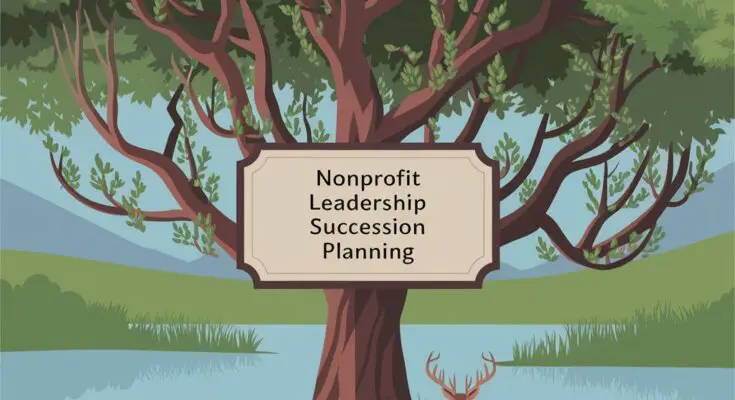Nonprofit leadership succession planning is essential for ensuring the longevity and success of any nonprofit organization.
It involves preparing for the future by identifying and developing potential leaders within the organization. Without a clear plan in place, nonprofits may face significant challenges during transitions, leading to instability and uncertainty.
Why Succession Planning is Crucial
Before diving into the strategies, let’s discuss why succession planning matters.
Imagine your nonprofit organization’s executive director suddenly announces their departure. Without a solid plan, the organization might struggle with leadership gaps, lose direction, and risk alienating donors and stakeholders.
Here are several reasons why succession planning is crucial:
- Continuity of Mission: A well-structured succession plan ensures that the mission of the nonprofit continues even when leadership changes. For example, if a beloved executive director retires, a robust succession plan allows the new leader to seamlessly carry on the organization’s work.
- Stability and Confidence: Knowing there’s a plan in place boosts confidence among staff, volunteers, and supporters. This stability encourages continued investment in the organization, fostering a supportive community.
- Talent Development: Succession planning nurtures the growth of internal talent, preparing employees for future leadership roles. By investing in professional development, nonprofits can build a strong bench of qualified candidates ready to step up when needed.
Basics of Succession Planning
At its core, succession planning is the process of identifying potential leaders within the organization and developing them for future roles.
This process includes assessing current talent, creating training programs, and establishing a framework for transitioning responsibilities.
Here’s a simplified breakdown:
- Identify Key Positions: Determine which leadership roles are critical to the organization’s success and need succession plans.
- Assess Internal Talent: Evaluate current staff to identify potential leaders who have the skills and dedication to fill these roles.
- Develop a Plan: Create a structured approach for grooming these individuals for future leadership.
Strategies for Effective Succession Planning
Now that we understand the importance of succession planning, let’s explore practical strategies that nonprofits can implement to create a robust succession plan.
1. Conduct a Leadership Assessment
The first step in succession planning is conducting a comprehensive leadership assessment. This involves understanding the organization’s current and future leadership needs.
- SWOT Analysis: Conduct a SWOT analysis to evaluate the organization’s strengths, weaknesses, opportunities, and threats. This will help you identify leadership skills that are essential for future growth.
- Stakeholder Feedback: Gather input from board members, staff, and volunteers about the qualities they believe are crucial for future leaders.
Example: A nonprofit focused on mental health services performed a SWOT analysis and discovered that while they had strong community engagement, they lacked leaders with experience in digital outreach. This insight informed their future leadership development strategies.
2. Identify and Nurture Internal Talent
Once you’ve assessed leadership needs, it’s time to identify and nurture internal talent. Look for individuals within the organization who demonstrate leadership potential.
- Create a Leadership Development Program: Implement mentorship and training opportunities that focus on cultivating leadership skills. Pairing emerging leaders with experienced mentors can facilitate their growth.
- Encourage Cross-Training: Allow employees to gain experience in various roles, providing them with a broader understanding of the organization.
Example: A nonprofit working in environmental conservation established a mentorship program where experienced leaders coached junior staff on project management and community engagement. This initiative helped cultivate a pool of future leaders.
3. Develop a Formal Succession Plan
A formal succession plan outlines the steps your organization will take when a leadership change occurs. This plan should include:
- Key Positions: List the critical leadership roles and identify potential successors for each position.
- Training Roadmaps: Create training roadmaps for identified successors, detailing the skills and experiences they need to develop.
Example: An educational nonprofit created a formal succession plan that included timelines for potential leadership transitions and training programs for identified successors. This structured approach prepared them for any unforeseen changes.
Reflect on Your Organization
Take a moment to reflect on your organization. Consider these questions:
- What leadership roles are essential for your nonprofit?
- Do you have individuals within your organization who could step into leadership positions?
- What challenges have you observed regarding leadership transitions?
Feel free to jot down your thoughts or share them in the comments section below. Engaging with others on this topic can provide different perspectives and solutions!
4. Establish Clear Communication
Effective communication is vital throughout the succession planning process. Keeping stakeholders informed creates transparency and reduces uncertainty during transitions.
- Communication Plan: Develop a plan for sharing updates about succession planning efforts with staff and stakeholders. Regular communication can help foster trust.
- Encourage Feedback: Provide opportunities for staff to share their thoughts on the succession plan and the leadership transition process.
Example: A local charity regularly updates its team about ongoing succession planning efforts through team meetings and newsletters. This transparency builds trust and ensures everyone is on the same page.
5. Document Knowledge and Processes
Knowledge retention is essential for a smooth leadership transition. When a leader leaves, they take valuable insights and experience with them. To combat this, nonprofits should focus on documenting key processes and knowledge.
- Create Standard Operating Procedures (SOPs): Develop SOPs for key roles and responsibilities within the organization. This documentation serves as a reference for new leaders.
- Facilitate Knowledge Sharing: Encourage leaders to share their experiences and insights through workshops or written documents.
Example: An arts organization developed a shared online resource where employees could document best practices and lessons learned. This repository became a valuable tool for new leaders stepping into roles.
A Journey of Transition
Let me share a story about a nonprofit that navigated a leadership transition successfully thanks to effective succession planning.
In a small community, a nonprofit called “Helping Hands” focused on providing food and shelter to those in need. Its founder, Sarah, had been the driving force behind the organization for over fifteen years. As she approached retirement age, Sarah realized the importance of planning for her departure.
Sarah identified her deputy, Mark, as a potential successor. Over the years, she had involved him in key decisions, sharing her insights about fundraising, community engagement, and organizational culture. Together, they developed a comprehensive succession plan outlining Mark’s transition into the executive director role.
When Sarah finally retired, the transition was seamless. Mark was well-prepared, having already established relationships with donors and community partners. The board and staff rallied behind him, and the organization continued to thrive under his leadership, launching new programs to expand their reach in the community.
This story highlights the power of effective succession planning and mentorship, ensuring that the organization remains strong and continues fulfilling its mission.
6. Regularly Review and Revise the Succession Plan
Succession planning is not a one-time event; it requires ongoing review and revision. Regularly evaluating the plan ensures it remains relevant and effective.
- Annual Reviews: Set a specific time each year to review the succession plan and assess the progress of leadership development initiatives.
- Incorporate Feedback: Use input from staff and stakeholders to refine and improve the succession plan.
Example: A nonprofit focused on education conducts annual reviews of its succession plan, adjusting it based on changes in staff, organizational needs, and external factors.
7. Foster a Culture of Leadership Development
Creating a culture that values leadership development is essential for successful succession planning. Encourage all staff to view themselves as potential leaders.
- Recognize and Reward Leadership: Celebrate employees who demonstrate leadership qualities, regardless of their current roles.
- Encourage Professional Development: Provide opportunities for all staff to attend workshops, conferences, and training sessions related to leadership skills.
Example: A nonprofit health organization introduced a “leadership spotlight” program, recognizing staff who took initiative in their roles. This encouraged others to step up and embrace leadership opportunities.
Your Call to Action
In conclusion, nonprofit leadership succession planning is vital for maintaining stability and continuity in an organization.
Now that you’ve learned about the importance of nonprofit leadership succession planning and effective strategies to implement it, I invite you to subscribe to the Nonprofit Navigators Newsletter.
By signing up, you’ll gain access to expert tips and resources, job and grant opportunities, exclusive webinars, events, and more. Let’s work together to ensure your nonprofit is prepared for a bright future!
Feel free to share your thoughts, experiences, or questions about succession planning in the comments below! Your engagement enriches our community, and we’d love to hear from you.




